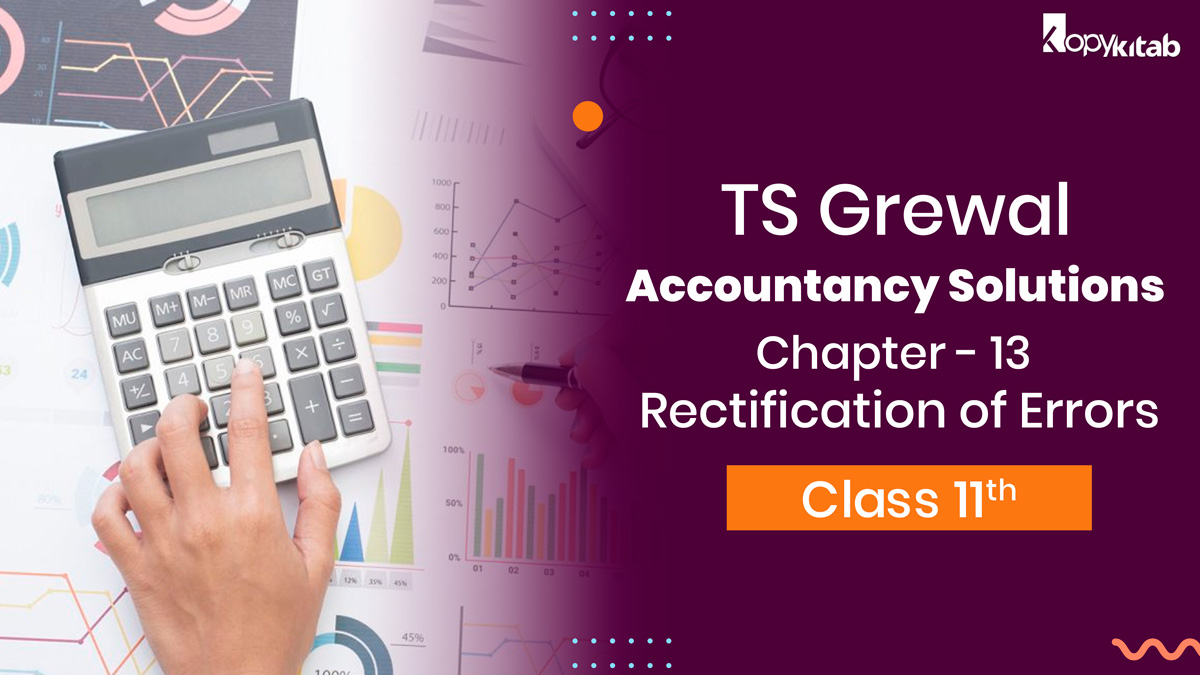
TS Grewal Class 11 Accountancy Solutions Chapter 13 – Rectification of Errors: Errors are something that could mess up the accounts of an individual or a company, rectification is necessary. TS Grewal explains Chapter 13 and talks about the meaning of the error, its types and how can it be rectified in an easy and detailed way. All the different procedures used for rectification are explained in the book.
- Read More: TS Grewal Class 11 Solutions
TS Grewal Class 11 Accountancy Solutions Chapter 13 – Rectification of Errors | Download Free PDF
TS Grewal Class 11 Accountancy Solutions Chapter 13
Chapter 13 – Rectification of Errors, TS Grewal Class 11 Accountancy Solutions. Detailed Explanation
TS Grewal Class 11 Accountancy Solutions explains the chapter by talking about the types of errors. So there are 2 categories of errors:
- The error of principle.
- Clerical errors.
- The error of principle: This type of error occurs when the transaction recorded by the accountant doesn’t comply with the rules of accounting. The rule states that for every debit there should be corresponding credit.
When a rule is violated, an error is caused which is known as the Error of principle. Recording this type of transaction doesn’t have any impact on the trial balance. It just means transactions are recorded in incorrect accounts. Eg: An asset is purchased and recorded as an expense in the account.
- Clerical errors: Errors generated from the improper recording of transactions. Clerical errors are of three types:
- Errors of Omissions
- Errors of Commission
- Compensating Errors.
Errors of Omission: Errors of Omission are the types of errors generated when the accountant forgets to record an entry. There can be two variations in this:
- The Complete omission of the transaction, not recorded in the books of accounts. Example: Failure in recording the purchase of an asset.
- The Partial omission of the transaction, the transaction is recorded on either the credit or debit side and forgets to record the transaction on the opposite side. Example: Credit sales of Rs. 2,000 to Raj. In this transaction, sales entry is recorded, but the entry for Raj’s account is not done.
Errors of Commission: Such errors are caused due to the negligence of a person, who is in charge of recording the transactions. It has an impact on the trial balance.
Example: Recording the incorrect amounts and incorrect totaling in the ledger.
Compensating Errors: Such a type of error occurs when one wrong entry neutralizes the impacts of another incorrect entry. These entries cancel the recorded errors.
Example: If Karan has purchased some goods for Rs. 4,000 and the same has been recorded in his account as debit as Rs. 400. This transaction would result in the reduction of the debit side by Rs. 3,600.
TS Grewal Class 11 Accountancy Solutions Chapter 13 – Rectification of Errors: Sample Questions
Sample question 1:
Rectify the following errors mentioned below:
- Purchases book is overcast by Rs. 10,000.
- Purchases Return Book is overcast by Rs. 1,000.
- Purchases Return Books’ balance is carried forward in excess by Rs. 100
- Purchases Books’ balance is carried forward in excess of Rs. 1,000.
Answer:
Journal
|
S.No. |
Particulars |
L.F. |
Debit amount (Rs.) |
Credit amount (Rs.) |
|
1. |
Suspense A/C Dr. To Purchases A/C (Purchase book overcast by Rs. 10,000, now rectified) |
|
10,000 |
10,000 |
|
2. |
Purchases Return A/C Dr. To Suspense A/C (Purchase Return Book overcast by Rs. 1,000, now rectified.) |
|
1,000 |
1,000 |
|
3. |
Purchases Return A/C Dr. To Suspense A/C (Purchase Return Books’ balance, carried forward in excess of Rs. 100, now rectified.) |
|
100 |
100 |
|
4. |
Suspense A/C Dr. To Purchases A/C (Purchase Books’ balance, carried forward in excess of Rs. 1,000, now rectified.) |
|
1,000 |
1,000 |
We have included complete information regarding CBSE TS Grewal Class 11 Accountancy Solutions Chapter 13 – Rectification of Errors. If you have any queries regarding the Class 11 Accountancy exam, you can ask in the comment box.
FAQs: TS Grewal Class 11 Accountancy Solutions Chapter 13 – Rectification of Errors
What are the categories of error?
There are 2 categories of errors:
1. Error of principle.
2. Clerical errors.
What are the types of clerical errors?
There are three types of clerical error:
1. Errors of Omissions
2. Errors of Commission
3. Compensating Errors.
Define Errors of omission.
Errors of Omission are the types of errors generated when the accountant forgets to record an entry. There can be two variations in this:
1. The Complete omission of the transaction, not recorded in the books of accounts. Example: Failure in recording the purchase of an asset.
2. The Partial omission of the transaction, the transaction is recorded on either the credit or debit side and forgets to record the transaction on the opposite side. Example: Credit sales of Rs. 2,000 to Raj. In this transaction, sales entry is recorded, but the entry for Raj’s account is not done.
Can I download TS Grewal Class 11 Accountancy Solutions Chapter 13 – Rectification of Errors Free PDF?
Yes, you can easily download TS Grewal Class 11 Accountancy Solutions Chapter 13 – Rectification of Errors free PDF.
